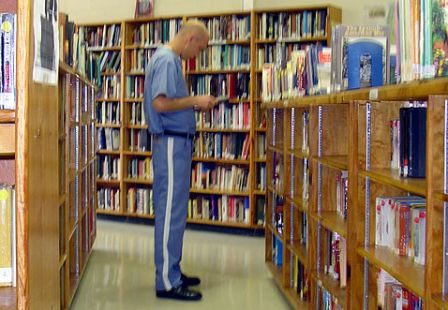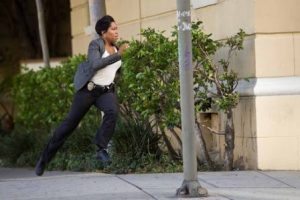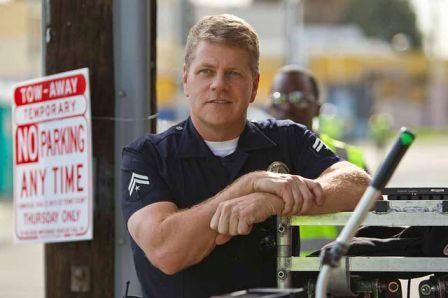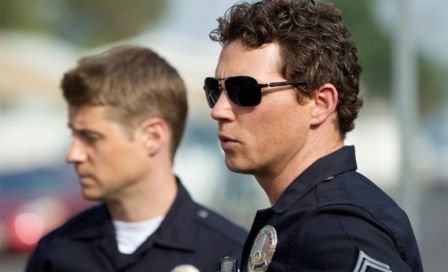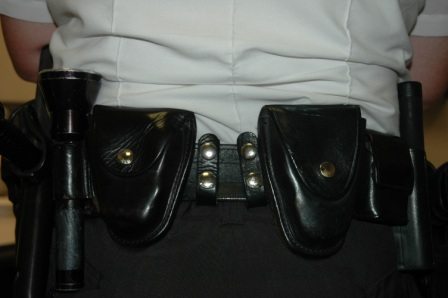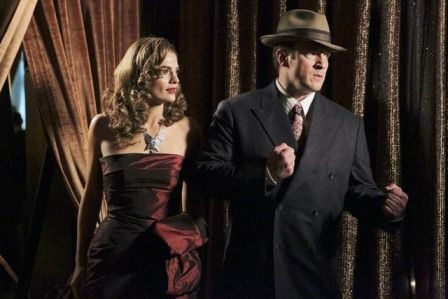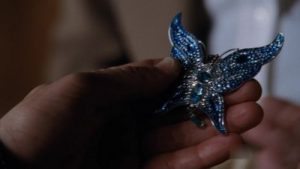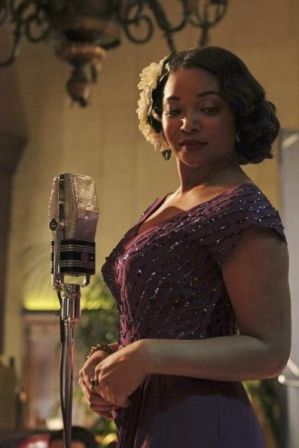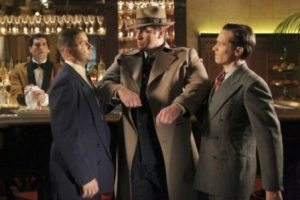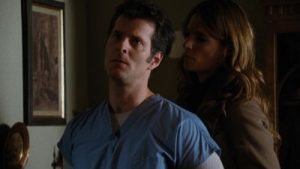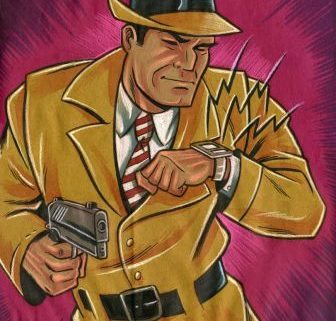Before we get into this review and recap, I have to say that I’m SO glad Beckett was never my partner. I mean, how many times during her career has she been kidnapped by the bad guys? (Remember the freezer? And how could we forget the old man-eating-tiger-in-the-basement trick involving Beckett and Espo). And, as they say on those annoying infomercials…But wait! This week she was abducted by both good and bad guys, in the same episode.
I’m beginning to think Beckett’s a pretty big liability for the NYPD. The big brass in the department must be aware of her and her troubles. Think about it. She’s the target for an assassin, her apartment was blown to bits, she’s kidnapped at least a couple of times a week, she places a civilian in jeopardy every day (he’s kidnapped even more often than Beckett), all her cases are solved by a civilian mystery writer, someone takes her gun from her two or three times a month, and now, after seeing the preview for next week, she’s going to lose her police car. Would you keep this employee on the payroll? And she wears crazy-tall high heels while tromping around crime scenes. Did you see the shoes she wore to the house of the female murder victim? Holy cow! They looked like stilts.
Anyway…Melanie, please take over before I put a stop to this by leaping out of my office window. Yep, this episode has nearly driven me to that point!

Melanie Atkins
Bodies flying out of windows and disappearing from the morgue. Rogue CIA agents. A major threat to national security. This Castle episode had it all. Too much of it, really. Just… no. To keep my mind off the over the top plot, I focused on another threat and potential blowup. The threat to Kate. This one irked me almost as much, but I hung in there.
The episode begins with Rick learning that Alexis is interning with Lanie in the morgue (holy voodoo forensics, Batman!), and he fears that having his daughter show up at crime scenes will cramp his style and disturb the amazing synergy between him and Kate. That’s not all that disturbs it, but I digress. Rick tries to talk Alexis out of continuing the internship, but to no avail.
Once the body disappears from the morgue (I’ll let Lee concentrate on the case here — such as it is), Kate and Rick search for the suspect, a man whose alias is Gage. Instead of finding him, however, they find another body — the body of the woman they’d thought he was going after. Then they’re kidnapped and taken to an unknown underground location. Way underground.

Lo and behold, they’re in CIA headquarters. A woman strides up to them… or rather, to Rick, and he immediately recognizes her as Sophia Turner, the CIA agent he shadowed for a time while writing the Derrick Storm books. Kate, of course, has read everything he’s ever written, and she pegs the woman as the inspiration for Clara Strike. Meaning… Rick’s had a muse before. Kate’s hackles go up, and she and Sophia square off. Can anyone say green-eyed monster?
Sophia asks for their help, wanting them to continue their hunt for Gage, and Rick jumps to say yes. Kate obviously doesn’t like this, but she has no choice but to go along. Once they’re in the car, however, she confronts Rick, saying, “It’s just that I might’ve been taken aback to find out that you have researched with someone else.”
His answer? “…it was a brief moment, a long time ago” and “Besides, Nikki Heat is a much more complex and nuanced character… and I’m a far more experienced writer. More mature.”

Then she learns he shadowed Sophia for an entire year. That did not sit well.
They don’t have much time to talk about it, because when they go looking for clues to Gage’s whereabouts, they’re grabbed again — this time, by their prey — and he stuffs them into the trunk of a vintage car. The car, of course, doesn’t have a latch inside the trunk. Kate gets them out, however, after learning Rick pressed the panic button the CIA put on his phone before Gage smashed it. Her motivation? “I will not be rescued by your girlfriend.”
His failure to dispute that connotation for Sophia irked me… almost as much as the theory building between Sophia and Rick once he and Kate are picked up by the CIA and whisked back to headquarters does her. I don’t blame her. The very idea that he would interact with another woman like that, after the I love you, gives me hives. I mean, seriously? What the heck are the writers thinking? Kate and Rick should be way past this by now.
That wasn’t the end of the jealousy, though. After the theory building, Rick tells Kate, “We’re all on the same team here” and she says, “No. You’re on her team (meaning Sophia), ’cause the way you look at her, you’re sure as hell not on mine.” Meow!
Again, Rick says nothing… and he even has the gall to stay home the next morning instead of going to the precinct. Aarrgghh! Come on, people. That’s way out of character.
Finally, though, Rick comes up with a new theory, thanks to Martha, and shows up at Kate’s desk eager to tell her about it. She scoffs at him and says, “Shouldn’t you tell Sophia?” Rick answers with, “She’s not my partner. You are.” Well, I guess that’s supposed to placate us. Kate seems to buy into it, but I sure as heck don’t. Can you say lame?
They talk again at the park while looking for yet another man, and Rick offers to answer any question Kate has about Sophia… a great idea, but of course they’re interrupted by the arrival of the person they’re after before she can even ask a question. The man orders them to take him to Pier 32, where he’ll explain about Pandora, a cataclysmic event that will destroy the country as we know it. A scary thought, but one that’s way out there.
He gets out of the car to go inside and someone shoots him… then a car slams into Kate’s Crown Vic, propelling it — and Kate and Rick — into the river. To be continued…
Sigh. I hope the second half of this two part event is more of an event. Ho hum… and enough of the other muses, old girlfriends, etc., okay? Rick’s already said he loves Kate, so get ’em together already. Too much chase and not enough reward… it’s getting old, people.

Lee Lofland
Okay, I’ve calmed down a bit now. Took a few sips of coffee and hit the play button on a little Beethoven. I’m relaxed. Calm. Shhh….
HEY!!! DID YOU SEE THE GUY FLY OUT THE WINDOW??? He hit the window pane and took all the glass and interior frame with him on the way down. Yet, when Gage the killer looked outside, he was peering through large jagged shards of broken glass.
Good, that’s out of my system. Now for Lanie…
– She says the 1st disappearing victim had several causes of death—shot, stabbed, choked, and had a pencil jabbed into his neck. And later, at the morgue, she lists several old injuries and odd characteristics about the dead guy—lots of old broken bones, scars, other injuries, and that he had the calloused hands associated with martial arts training. What? I’m sorry, are there special callouses for special circumstances? I mean, can someone tell that callouses on the hands of a farmer are the result of setting fence poles by hand? How about the hands of gardener? Could an M.E. tell those callouses were the result of digging in the soil?
What’s so freakin’ special about the callouses on the hands of someone who’s proficient in, say, Aikido? Well, for starters, I’ve been involved in that sort of thing since my teens (five or six years at least) and I’ll tell you, callouses aren’t a big result of the training. This comment, Lanie, was dumb. Yes, I know you were setting the guy up to be what he was, a tough-guy-secret-agent-killer-sort-of-guy, but it was still dumb.
– How could someone get a body out of a morgue without one of the many people who work there seeing it happen? I won’t even bother to go into that ridiculous notion.
– Beckett and Castle go to the home of woman who’s been murdered by the evil and nearly supernatural “Gage.” (This is the scene where Beckett’s wearing the stilts). The two know that this Gage guy is extremely dangerous and has already killed at least two people. So what does she do first? She squats down beside the body conducting an everyday conversation with Castle. Then, after a minute or two, she tells Castle, who’s unarmed, by the way, to stay with the body (no problem with chain of evidence and custody here, huh?) and she starts off on a slow search of the house…for the madman, psycho killer! NO, no, and no! Make sure the scene is safe and clear before engaging in idle chatter. Killers do hide and sneak up on people.
So what happens next? Of freakin’ course Castle has been captured by the bad guy who literally “pulled the wool over his eyes.”

The show was already ridiculous at this point, so you know what would have been really cool here. The hood should have had the word WRITER printed on it just like Castle’s Kevlar vest. Funny? You know it!
Anyway, this is where Castle and Beckett are kidnapped for the first time in this episode, courtesy of the CIA.
– Here comes Lanie with her new sidekick, Alexis. My thoughts on Alexis in the morgue. Here you go…

I do think, though, that Castle plays the role of a pretty good dad, especially as a single father.
– Lanie says the M.E. almost always beats the uniforms to a murder scene. Hmm…who does she think usually calls the M.E.? THE COPS!
I apologize for shouting, but this episode was…no, I’ll just continue.
Enter the CIA, an outfit that’s not set up to work criminal cases (murder, etc.). They may instigate crimes, but as a rule they don’t investigate them. You will probably never see a CIA on the stand testifying in a B&E case. So, they’ve kidnapped Beckett and Castle and now want them to go after that superhuman Gage guy.
Let’s study on this for a moment.
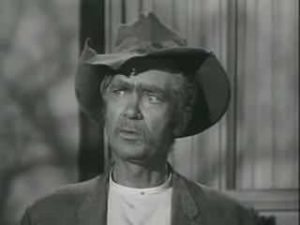
Okay, we’re back. Did that second or two of silence help? Let’s see. The CIA guy methodically says to Castle and Beckett, “This…is…a…national…security…threat.” He’s talking about the unstoppable killing machine, Gage, who’s already taken out the CIA’s top guy. And before I go on I’d like to ask the CIA folks from this show a question. If Gage was such a threat to the USA, enough so that the entire country could go up in smoke, and if the guy is so unbelievably dangerous, then why in the world did you only send one guy to capture him. And not even a healthy guy at that. The guy they put on the trail was a has been—shot up, broken, cut up, and probably brain damaged from all the injuries he’d received over the years. And, obviously, he wasn’t very good at self-defense. That’s what the CIA chose to send after Terminator?
– How about locating the briefcase/cellphone in the trunk of the old car. Beckett keeps her back to the dark garage, again, knowing that Gage was still out there somewhere, while she opens the case. Guess what…yep, kidnapped again. This time she and Castle are locked inside a car trunk.
I’m not even going to mention all the hocus-pocus gadgetry used in the show. And don’t you just love how there’s always, always, always a camera in the exact spot where it’s needed to identify someone, or to locate a piece of evidence.
But Castle is an inspiration. He’s made me realize that for years we’ve been going about crime-solving in all the wrong ways. We should stop assigning cops to investigate murders, rapes, and robberies. Instead, we need to turn over those duties to the various chapters of Mystery Writers of America, Sisters in Crime, Romance Writers of America, and International Thriller Writers.

Now those writer-folks really know how to solve a murder.






































